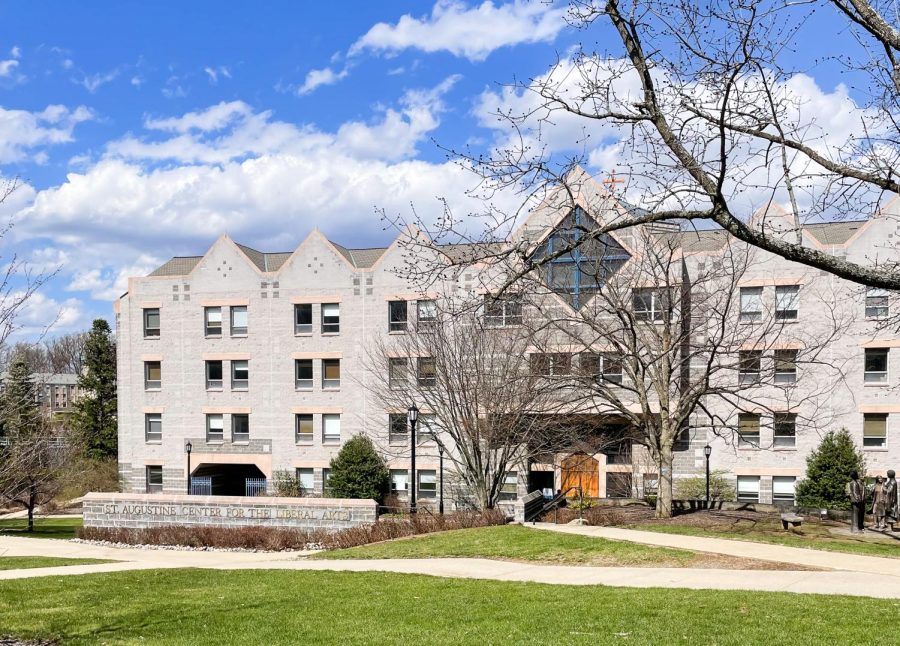CLAS Should be Divided Into College of Arts and College of Sciences
The St. Augustine Center for Liberal Arts hosted Anelise Shrout’s event analyzing her book.
April 13, 2022
The experience that a liberal arts or social science major has at Villanova is vastly different from that of a natural science major. I spoke to both arts and sciences students about whether their academic careers would have benefitted from being a part of a unique college. The consensus was that CLAS should be separated into a College of Arts and a College of Sciences to clarify admission and coursework requirements as well as improve the overall student experience.
A key aspect of Villanova’s academic mission is for every student to receive a well-rounded education and develop essential critical thinking and communication skills. These skill sets are meant to be fostered through the many foundational courses that CLAS students are required to take.
Ultimately, I am not arguing that this core curriculum should go away or be majorly altered. Rather, certain aspects of the core curriculum should be adjusted based on whether a student is pursuing humanities or the natural sciences.
At Villanova, CLAS awards both Bachelor of Science and Bachelor of Arts degrees. Astronomy, chemistry, biology and computer science, for instance, are all Bachelor of Science degrees, while English, Political Science and Sociology are all Bachelor of Arts degrees. The nursing school offers one degree (a Bachelor of Nursing) and the business school offers one degree (a Bachelor of Business Administration), so students pursuing a Bachelor of Science should similarly be housed in a different college environment than students pursuing a Bachelor of Arts.
Beyond this, natural science students apply and are accepted directly into their major, while initially, “the only option available to applicants interested in the liberal arts is Exploratory Arts,” according to the Office of Undergraduate Admission. Students then spend at least one semester as an Exploratory Arts student, and must declare a major by the end of their sophomore year. Seeing that the admissions process is completely different for natural sciences versus the rest of CLAS, it doesn’t make sense that they are considered a part of the same college.
According to the CLAS Handbook, students receiving a Bachelor of Science degree are exempted from the Natural Science requirement in the core curriculum because they “meet the science requirement through the regular program of study in their major.” However, this same courtesy is not extended to liberal arts majors. English majors are still required to take the Core Literature & Writing Seminar (a class designed for non-English majors) and History majors are still required to take a designated Core History class.
Science majors also spend significantly more time in class per week due to the lab requirement.
“In order to not fall behind, freshmen year Biology majors have to take general biology and general chemistry (both with three-hour labs) at the same time in addition to three other classes, and later organic chemistry and genetics at the same time,” senior Bella Wu said. “I spent 19 hours a week in class to earn 17 credit hours, which is unhinged.”
Scaling back the number of liberal arts core courses for students in a College of Sciences – or at the very least, allowing them to use their hard-earned AP credit to replace them – would make graduating on time much more manageable.
Because CLAS advising and professional development efforts must be shared between liberal arts, social science and natural science students, they are very broad with advisors from a variety of disciplines. Senior Sydney Stewart, who is pursuing a career in foreign service, encountered difficulties with advising because CLAS does not offer a major in international relations like many of our peer institutions do.
“Many arts careers have such unique professional paths that one advisor cannot possibly understand multiple majors, especially when trying to offer advice for the rigid science career field versus the very abstract arts field,” Stewart said.
CLAS also lacks peer advising or alumni mentoring programs like some of the other colleges at Villanova have.
“If Arts and Sciences were to be separated, Arts would have a greater capacity to incorporate more diverse majors and attend to their students further,” Stewart said.
The application processes, course loads and academic experiences of students studying natural science are vastly different than those of students studying liberal arts or social sciences. Villanova should divide CLAS into two separate colleges in order to streamline operations and better serve students’ specialized needs.


